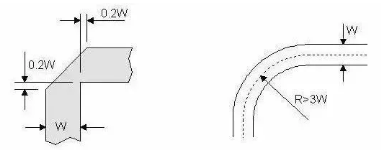
As PCB design engineers, we all know that impedance should be continuous. However, PCB design always has impedance can not be continuous, at this time how to do?
What is impedance

What is impedance continuity
Solution to impedance discontinuity
A.Gradient line
Some RF device packages are small, SMD pad width may be as small as 12mils, while RF signal linewidth may be more than 50mils, so gradient line should be used and sudden change of line width is prohibited. The gradient line is shown in the figure, and the line of transition part should not be too long.

B.Corner
If RF signal line runs at right angle, the effective line width at the corner will increase, and the impedance will be discontinuous, causing signal reflection. In order to reduce the discontinuity, there are two ways to deal with the corner: chamfering and fillet. The radius of arc angle should be large enough. Generally speaking, it should be ensured that R > 3W. As shown on the right.

C.Large pad
When there is a large pad on a 50 ohm thin microstrip line, the large pad is equivalent to the distributed capacitance, which destroys the characteristic impedance continuity of the microstrip line. Two methods can be used to improve the performance: firstly, the dielectric of the microstrip line is thickened; secondly, the ground plane under the pad is hollowed out, which can reduce the distributed capacitance of the pad. As shown in the figure below.

D.Via
The via hole is a metal cylinder plated outside the through hole between the top layer and the bottom layer of the circuit board. Signal vias connect transmission lines on different layers. Through hole residual pile is the unused part of through hole. Via pads are ring shaped gaskets that connect vias to top or internal transmission lines. The isolation panel is an annular space in each power or ground plane to prevent short circuit to the power supply and ground plane.
E.Through hole coaxial connector
Similar to the via hole structure, the through-hole coaxial connector also has impedance discontinuity, so the solution is the same as the via hole. The common methods to reduce the impedance discontinuity of through-hole coaxial connector are the same: adopting diskless process, appropriate outlet mode, and optimizing reverse pad diameter.